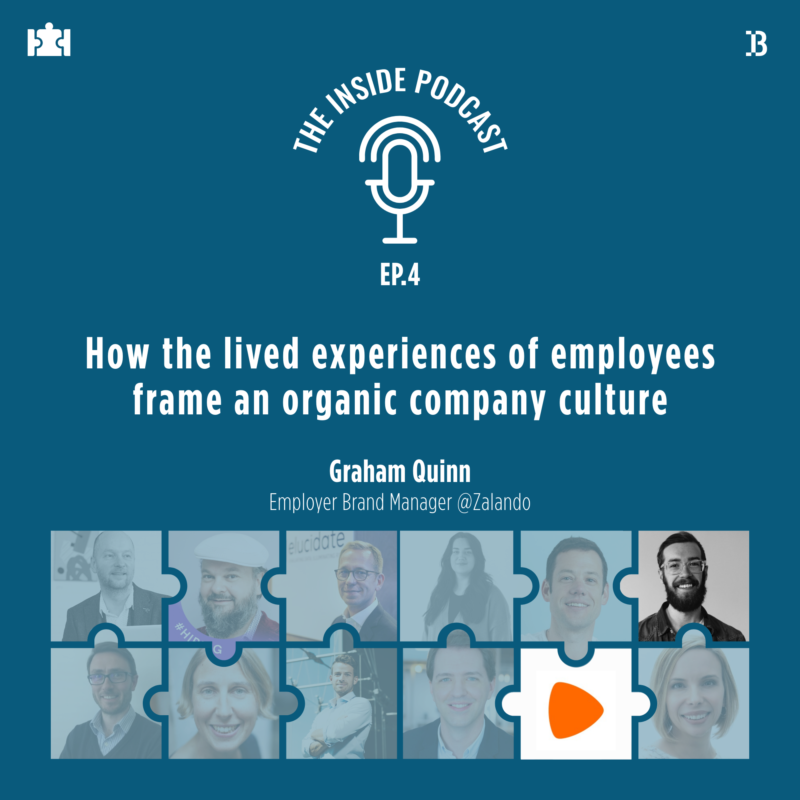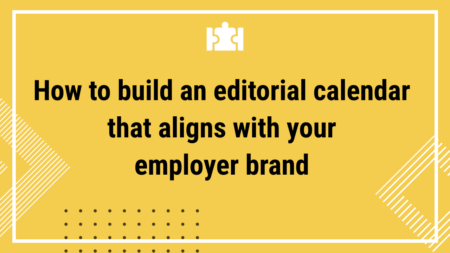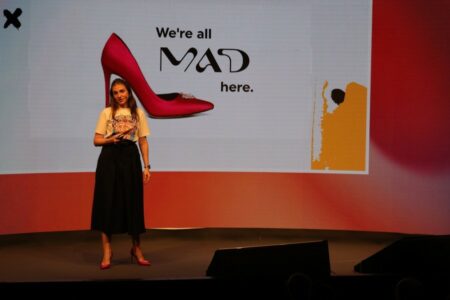Hi, my name is Georgiana. I am the CEO and founder of Beaglecat, and soon you will be listening to Employer Branding: The Inside Podcast. In this podcast, I regularly talk to employer branding managers and acquisition managers, and human resources managers in tech companies in Germany, Romania, and the US. For more content on employer branding-related themes, go to employerbranding.tech or beaglecat.com. Stay tuned!
Overview
It’s #ThursdayPodcast once again!
In the 4th episode of #EmployerBranding: The Inside Podcast (season 6), we had a fantastic opportunity to speak with Graham Quinn, Employer Brand Manager at Zalando.
We discussed designing high-performance cultures, employee retention strategies, and onboarding best practices. Also, we debated how companies frame their cultures and how employees’ lived experiences frame an organic, honest organizational culture.
What you’ll learn by listening
- How cultural is employer branding?
- How can small companies kickstart employer branding initiatives?
- Purpose vs benefits – what matters more when attracting top talent
- Designing high-performance cultures
- Employee retention strategies: what works and what doesn’t
- Pros and cons: offering employees stock options
- Employee onboarding best practices
About Zalando
Founded in Berlin in 2008, Zalando has grown from being a pioneer in the world of e-commerce to becoming a leading European online platform for fashion and lifestyle. We connect customers, brands, and partners in 25 markets and employ more than 17,000 talents from 140 countries. We drive digital and sustainable solutions for fashion, logistics, advertising, and research bringing head-to-toe fashion to almost 49 million active customers, fueled by our vision of becoming the Starting Point for fashion – one that is welcoming to everyone.
Podcast link – Enjoy listening on Spotify!
Podcast transcription – Employer Branding T.I.P S06Ep.04
Georgiana:
Hi, everyone! Here I am today with a new episode of Employer Branding: The Inside Podcast. My guest today is someone from Zalando, someone who works here in Berlin, but who has a history of having lived elsewhere as well, his name is Graham Quinn. Welcome, and thank you so much for accepting to do this episode with me. Graham is one of the employer branding managers at Zalando. But I’d like him to first introduce himself, if that’s okay with you, Graham, and to tell us exactly what you do as an employer branding manager.
Graham Quinn:
Sure, that sounds great. Hi, everyone. I’m Graham, and I’m an Employer Brand Manager at Zalando. What I do in my role is to identify and broadcast the unique opportunities of our culture to reach and continuously captivate that value-added talent, and help position Zalando within the global, wider talent landscape. More holistically, I’m a globally experienced professional specializing in brand strategy, employer branding, marketing, communications, and content management and development. There were seven years in the marketing and employer branding space.
Georgiana:
Okay, um, I’m wondering why you chose Berlin, after Canada, of all the cities you could have come to.
Graham Quinn:
So it’s more about transferring my skills and being able to work in a recognized and established team within a well-established company, within the European landscape. So it’s a few different factors. But I’m so glad to be here. And it’s been a great learning experience so far.
Georgiana:
It’s actually really interesting to me because I tried to have as many guests from the countries that I’m most accustomed to, which are Romania, Germany, and the US because I’ve also traveled quite a bit to the US. So for me, each guest’s cultural experience with employer branding is really, really relevant. And I think we have a lot to learn from it. So I’m wondering, what’s your take on this? Do you think Employer Branding is cultural? Is it just budget-dependent? What has your experience been in Germany versus for experience with companies in Canada, for example?
Graham Quinn:
Yeah, great question. I think, a few different things, I think it depends so much, it’s so unique to different companies. Because when you work, I’ve worked at companies where it was about 20 of us to now where I currently am, there’s 10,000 of us. You needed to be both. So you need the buy-in from senior leadership, you need sponsors to really kick off and fire burning internally. And that’s not to say that you need budgets.
Within my marketing career, I’ve had a little budget before and was able to get things kicked off but it’s also against the goals and KPIs you’re working towards and what you’re trying to achieve. And if there is a budget, there’s top support. So again, it’s also about the expectations a company has and so I’d say that you know, it is very dependent on the companies and has that uniqueness to it. But I think the main thing is that it has to be cultural. You need buy-in from senior leaders, you need buy-in from employees throughout the organization.
And I guess in terms of budget, it just really depends on how much you really want to move forward at a quick speed versus under very little speed. But then the day you do need some budget, whether it’s graphic design or you know, even if it’s just doing it yourself in Canva, for free. But there are a lot of different ways that you can go away the budgets dependently. It’s of an organization if you’re working with little, very, very little budget as well.
Georgiana:
So do you think it’s a question of creativity in the end for these companies that don’t have a big budget? Because we know so many successful campaigns from companies like Zalando or Oracle, Cognyte. What can a start-up do? What can a small company do to have good employer branding in place? Aside from budget, of course?
Graham Quinn:
Yeah, I think that’s a great question. I am biased in this sense. Because I feel like a lot of tech startups when it comes to employer branding or any startup, there’s a lot more wiggle room and a lot more freedom and mobility to really move things up with speed. So I think it’s really just trying to prioritize what you’re trying to achieve and seeing, going back to the drawing board to understand like, what are our current problems? How can we solve it? And what do we really need to get kicked off the ground?
And that’s not to say that a lot of these employees, your co-workers are going to have time and resources to help support you. But you know, as a team of one in a lot of these environments, you really do need support in some way. And everyone has their own creativity. But it’s nice to be able to rely on different organizations out there to connect with these individuals, get their ideas, and really take from that approach. Because, again, it’s one of those things where I feel like you can move a lot quicker in a startup environment with employer brands. And there’s a lot of unknowns there and how you’re going to tackle things. But I think there’s a lot more freedom in it. And it’s always better when you go about it with other people outside of your company throughout the industry.
Georgiana:
And what has your feeling been so far? In Germany, you’ve been here quite a while, right? And I have also been here for about four years now. I’m wondering, are people in tech mostly attracted to tangible benefits? Or to company purposes? What would you say is the ratio or what has your experience been?
Graham Quinn:
Yeah, that’s a really great question. I think companies have a lot of misconceptions about what tech talent are attracted to. If we go back to about five years ago, humans and people or companies are focusing on ping pong tables and beer tabs. When it comes to tech talents, if we’re talking about like software engineers, and whatnot, then it’s, of course, salary and comp have a certain alert to it. But then the day, I also do think it’s about what they’re working on. How it connects to the company’s vision, and the individual’s mission, beliefs, and value system. So I think it’s one of those things, at least so far in Germany. I mean, especially in Berlin, Berlin is a very liberal city.
And I feel like especially in Berlin, a lot more individuals are kind of geared towards just companies that have their values align with their own, so it’s more purpose-driven versus benefits driven. Because there are a lot of tech startups in Berlin, a lot of tech companies. But at the end of the day, it’s not so much. The perks and benefits are really tracking to them. To them. Not in regards, I’d say it’s more regards to, you know, I really believe in diversity or sustainability. Does this company really match my belief system, and what it stands for, and how I can help support it? So I think there’s more of that cultural by him and I would say that financial aspects.
Georgiana:
Okay. We wrote an article at some point about how to build a strong company culture or how we can attempt to build a strong company culture. And while writing it, we came across this interesting quote, which I’m gonna read to you. “High-performance cultures don’t happen organically. They’re designed, architected, and built with intention, your intention”. Agree or disagree?
Graham Quinn:
Yeah, I think I disagree with that. I think from what I’ve seen, there are a lot of companies out there trying to build their culture within their own organization or emulate other company’s culture. If you’re a tech company, you want to be the next Shopify or the next Facebook, but you can’t base your culture off of another company’s culture, which is one thing, but at the end of the day, your culture isn’t what you say it is, it’s people’s lived experiences within the organization.
So I would say it actually happens more organically. And you can have a guiding framework to say this is our culture, and you can build it with intention. But then the day it is very much about how it is internally, how your employees experience it, and how they navigate the company. So you know, if you’re talking about transparency, and your company is not transparent at all, the culture, it’s not what you intended to be. But it is the culture at end of the day. So I, yeah, I would have to disagree. And I think it’s just one of those things that companies might have to just shift their minds off, on in terms of their perspective, because, yeah, during the day, as your employees come here, every day, they spend eight hours a day.
That’s how they shaped that culture. It’s how they buy into that culture, and it’s their lived experiences throughout. So it may vary by team and they vary by department. But there are a lot of factors at play, but I’ve been a day, your culture isn’t what you say it is, it’s the lived experiences of your employees.
Georgiana:
Exactly, exactly. And at the end of the day, the employer brand is also about that.
Graham Quinn:
I think there are a few different ways companies can tackle it. But I think at the end of the day, it’s that current economic situation or any economic situation. I’ve worked at companies before where employees are given stock options, and they invest at different periods. And so it might be a year, it might be three years, and you get the bulk of it, maybe at five years. And then I’ve worked with other companies as well, where you buy into the plan every month, and at the end of the business quarter, you get your matching options. So it’s a vesting period of three months.
And I think there’s a key differentiator between these two companies per se, as a company A, you know, investing every three or five years, and then Company B is investing quarterly. I think there’s a harder buy-in option when you’re talking about investing or working at Company A because you don’t really see the value or the benefits of staying for a year, only your award options are like 1000 euros per se. So it’s harder to do three years and five years. I feel quite controversially that those stock options for companies who are best at one year and three years, it’s really good to benefit the company, but employees don’t really see it.
Because for tech companies, especially why this happens, employees aren’t sticking around for three years and five years, and most likely gonna leave after two years. So it’s at the end of the day, they’re saving money, it’s a cost-saving measure attraction aspect, but then the day, they’re saving money, they don’t have to pay for your pension, they don’t have to pay for, you know, if you’re in Canada, your RFP, or your IRA or your RA. So I think those companies are doing it very strategically, in the sense of like, hey, come join our company, we have stock options back in the day, you know, it’s, they’re saving money. And then you have the other companies like Company B who’s giving their employees stock options every quarter.
And you are more invested in the company in that regard. Because you work more towards let’s build a great company because I can see the results of this after every quarter, I get my options every quarter, and it’s more costly for the business. But at end of the day, it’s a higher engagement rate within the employee stock purchase plan, more employees feel engaged, connected to the brand, and really want to see its success of it. And I think that’s a better retention measure. But I think what we can all see as well, as you know, is we look at other companies who’ve had their stock tech stock options cut in half. They’ve lost growth within the past year to the current economic situation. Does it even make sense to offer stock when tech stocks were overvalued to begin with? They’ve dropped significantly within the past year.
Georgiana:
Exactly and we’ve all heard these horror stories of companies not having a good time in the end with people who are so were promised so much in terms of stock.
Graham Quinn:
Yeah, and it’s also one of those things to where you have to really buy into the belief that stock will really take off. If you know it’s not a publicly traded company yet, if they haven’t reached IPO status. I see a lot of unicorn companies doing that too, you know, or like where Berlin’s biggest tech unicorn or Canada’s biggest tech unicorn, and you know, that’s great and all. But that’s not a retention measure, because it may never get to IPO status, you may never even see your stock options best, you really have to believe in the product.
But I’m also at the age where I care more about my retirement and receiving a monthly allotment a monthly versus stock options that may cut in half the price stock price might cut in half, or am I never gonna get them I care more about. Yeah, I mean, it’s, it’s very boring in that sense. But I rather have a company match my contributions to my right, my retirement fund or my pension, and see the results of that in 10, 15 years or 20 years. But I think it’s still one of those cases where we haven’t really reached that stage yet. And ESPP plans are still kind of seen as a gold standard. But it’ll be interesting what happens when it comes out of this current economic cycle.
Georgiana:
I think in the end, in my opinion, at least, it also depends on the type of person to which you’re directing this messaging and to whom you’re targeting ESPP. Because I see it happening with people who are younger or more eager to take risks. They don’t really mind working long hours and receiving less money as long as they have a stake in the company.
Graham Quinn:
That’s another great point as well. You know, if we’re talking about the younger generation who are just starting to get into the workforce. I don’t know about the European schooling system or the education system, but in North America, you don’t learn much about finances when you’re in high school. When it comes to stock purchase plans, and employee stock purchase plans, a lot of these individuals don’t really know what a vesting period is exactly. It wasn’t till my third or fourth company, I worked for like a well-known multinational brand.
And it was until after I left, I realized that I missed a great opportunity to invest in company stock because I wasn’t aware of the terms. And so I think that’s also another fault of these stock purchase plans is that they don’t really have a great awareness level as to what these different terms and definitions really mean for the employees. If you invest so much, you get so much back. And I think that’s still another area of education, especially with company pensions, a lot of people don’t understand the free bet free money that’s sitting there right there sitting in our lap if they just contributed the minimum.
So let’s say a company says you contribute 50. And we’ll give you 50, as well, like that’s free money sitting on your lap. And I think that there just needs to be more awareness and education to both, you know, employee stock purchase plans, the definitions, how they work, as well as pension plans and how it’s free money just waiting there for you.
Georgiana:
For me, at least it would be questionable if the company offered these opportunities for stock but didn’t really explain a lot, about what’s behind them and wouldn’t be completely transparent about them. That will make me wonder if maybe there’s something hidden, maybe they don’t see themselves as having a successful opportunity of being sold or acquired by someone else, or I don’t know, my stocks won’t get anywhere. At some point. This is what I would think.
Graham Quinn:
Yeah, and I think that’s a valid concern. I’ve actually seen companies come in, in the marketplace where you can sell your employee shares to these companies, in case you don’t have the confidence that it’s going to go anywhere. It’s essentially opening up this pre-IPO market for company stocks. I think that’s a real concern. I think these days, it’s Flip or Flop, but if you know, like Aaron b&b was a big you know before they went, I want to IPO status was a very big risk. And, you know, it’s you have to be comfortable with that. I think at the end, the day is like, do I really want to take this massive amount of risk and go is the stock options that may never invest or go to IPO status? Or do I rather just take something more stable? It all comes down to the person to decide that.
Georgiana:
I think so too. What I’d say it’s anyway, it’s something that I personally didn’t give a lot of thought to, and I certainly will. I’m gonna look into this, or maybe even write something about it. What do you admire about the employer branding policies, Graham?
Graham Quinn:
Yeah, I think it’s I don’t know if it’s so much about policies, I think it’s just, I’m taking like a very key nine right now to these companies who have built employer brand teams and how they navigate these waters of layoffs and redundancies. One of my favorite examples is Airbnb. When the pandemic started, they laid off a huge amount of their workforce. But they did it and delivered it with such empathy at the core, that it’s been a great success for the company in terms of their employer brand efforts after the fact.
But it’s also one of those things to where I connect regularly with my practice my fellow practitioners at various companies throughout North America and Europe. And, you know, I refer friends and I hear about like negative stories about candidates not getting any feedback or whatnot. And it just makes me not want to work for the company, based on how they deal with their candidates. And that kind of goes back to your question. I don’t know if I have any favorite company that I really admire their policies for their vision. It’s also one of those things to where it’s like, at what point do you recognize it from the brand perspective versus the employer brand perspective, Uber is a great example of brand perception.
But you know, there’s the negative connotation around being a delivery driver or a driver for Uber. But then you look at Shopify, which is the Canadian success story. And everyone wants to work for Shopify, it’s a great employer brand as a great consumer brand. And they’ve handled their layoffs. But I just don’t know if there is any one company, I would say that I would fully stand behind. Yeah, I think it’s such a tricky thing. And it just like depends on what they’re going through and how they do it. But I’ve also seen great examples.
Georgiana:
Now that I’ve actually stated the question out loud, it seems a little bit too hypothetical. Because I see what you mean, I think it’s very hard to form an opinion about a company based only on what you see from the outside. Even if you look at Glassdoor, even if you look at all the other open, what are they call the other employee review websites, you might still not get a true feeling of what the company is like.
Graham Quinn:
Yeah, I mean, I kind of disagree there. I think being in the employer brand space, like you and I both are, we’re aware of the strategies, and we’re aware of how companies do it. So I’d say that we’re more hyper aware of like, how companies are perceived like we have a fine keen eye to see how it really is portrayed. It’s like the general public’s view, it’s hard to see how brands really do it. But you know, I’ve admired certain employer brands and certain companies, and I’ve had friends who’ve interviewed for positions, they’re like, I’ve referred friends to positions, and they’ve never even been, they were never recognized, they were never called out upon. And it just changed my view of them as an employer. And, you know, both as an employer and I would never really use a product, to begin with.
Georgiana:
Yeah, but that’s sort of a personal experience with the brand, even if you’ve referred to the brand. And I’m saying that because I sort of changed my opinion on the topic this summer when I started to apply for jobs here in Berlin. I didn’t apply for many jobs, I sort of did it just to see if it gets me anywhere, because I was looking for a change from entrepreneurship to a full-time job.
And I have to say that after having applied to five, or six companies and having received the most typical boring, annoying replies from the majority, I have changed my mind and my opinion about a great deal of them. I’ve changed my mind in a positive way, when I received consistent feedback, although it was negative, but really well argumented and things that I actually could apply for my CV and for my future cover letter.
Graham Quinn:
Yeah, I’ve definitely interviewed when I was looking for jobs a few years ago, I was definitely in that spot as well. I interviewed with companies who had no idea what employer branding was, but they deliver such a great candidate experience. They were very human. I think there are two other companies as well, you have another company that knows what employer brand is. Well, they think they know what an employer brand is. And they just try and market their way through the system they like, they make it like a magazine, you know, it’s very glossy. It’s very salesy and whatnot, but it’s a terrible culture.
And then, as you mentioned, I think it’s the other opportunities to where people are aware of employer brands are obviously hiring for someone to help them with their employer brand. Their templates aren’t great. But I think from our perspective, how much do I really want to? How much does this inspire me to really make this company better? So it’s that inspiration aspect of how much can I change. So I think it just depends, really, per company, but and how your personal experiences.
Georgiana:
And that leads me to our last question because we’re approaching the end of this episode. And wondering if so far in your career, there has been a project in which you feel you’ve accomplished a lot with employer branding, or maybe a project to about which you feel very strongly or a project in which you would have acted differently from the point of view of strategy.
Graham Quinn:
I think the biggest project I’m keen on is really taking it from the candidate experience point of view, and employee onboarding. I think those are the two first steps within the employee lifecycle that really can deliver a lot for our employer branding that I feel most passionate about. Because at the end of the day, we’re humans and we should be treated as such. In terms of recruitment, I was a recruiter in my previous role as well as an employer brand manager.
And that’s always what I strive to deliver to my candidates is feedback, consistent feedback, consistent status updates, because it’s one of those things where that’s setting the stage to the employer brand. That’s the first tangible interaction the candidate had with your employer brand is the employee experience. So the recruitment process. And to that point, as well, from there, once you get hired, you go into onboarding. And poor onboarding experiences have shown to be a key factor for high turnover rates within the first six months.
Georgiana:
Because they make it or break it right after the call, you say, I want to work here, or I’m out of here in a while.
Graham Quinn:
Exactly. I’ve had friends who work for these major world-renowned brands, and you know, looks great on their CV, and they’ve texted me and they’re just like, Oh, I had a really terrible onboarding experience. I just love to figure things out on my own. And I’ve had my own share of experiences, poor onboarding, and it doesn’t really make you, if you don’t feel connected to the brand, you don’t feel engaged, you don’t feel bought in. And I think there could be a lot of value there in terms of improving it.
So you get that buy-in before I even joined from day one. Yeah, I think it was one of those things where a lot of work can be done. And I think that’s where I would really start and where I’m really passionate about starting in terms of getting companies aware of it is there are so many little wins that you can do that can really help set up the stage for bigger wins down the road in terms of employer branding, activities that you do.
Georgiana:
I was thinking the same because I’ll be starting this new role as Employer Branding lead. And, of course, I haven’t been on-boarded yet, because I haven’t started. But I have all these thoughts running through my mind, I could do this. And I could do that. And I could focus on this. And I could focus on that. But in the end, I think it cannot focus on everything, and you cannot change everything and you cannot do everything. So but it makes a lot of sense that you put effort and thought into the onboarding process because once you make that person feel human, you’re probably increasing your retention rate.
And that’s something that so many companies struggle with here in Berlin, you hire them and then you delete them, then they leave them there. So you’re constantly looking for a replacement and like, like one of those games that to me, sounds very funny, because there’s a lot more companies could do and they don’t
Graham Quinn:
Yeah, especially in Berlin. It was a complete culture shock to me that it’s a three months trial period. That was a huge shock to me. Back home, it’s two weeks. And so there’s a greater chance for these people to drop out of the process before they even join and yet it’s still not a huge consideration for these companies to even focus on the onboarding. You know, it’s like well just leave them alone for three months after they say yes, and then we’ll start on More than that from day one, but I think they’re missing out on a key opportunity to really get that employee engaged from the day before day wondering.
Georgiana:
Once again, thank you and I look forward to meeting you in person at some point.
Graham Quinn:
Thanks again, for having me here. And it’s been a pleasure to be a guest on your podcast.






